Tag: Grow Tubes and Vines
No Grow Tubes, No Round Up, No Sweat. (Well, maybe a little.)
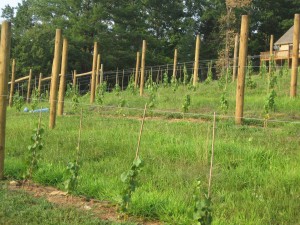
A view of our vineyard
We decided a year ago, after planting a small, educational vineyard (i.e., seven vines, planted for the sole purpose of getting some hands-on experience with viticulture) to forego the use of grow tubes. That was a tough choice. Almost every vineyard we’ve visited nurtures young vines in grow tubes, and there’s probably good reason to use them in large commercial undertakings.
But we decided against them for our small hobby vineyard for reasons that we think make sense. Most of the research we’ve looked at suggests that vines raised without grow tubes do better in the long run than those that spend their formative months inside protective shelters. We happened to speak to a vintner from South Africa over the weekend, and he echoed our views, noting that he had not even seen a grow tube before arriving in the United States. He still believes, he said, that the vines are better off without them.
But, of course, everything comes with a price. And this weekend, we got a real taste of the price you pay for growing vines without protective shelters.
The main reason vineyards love grow tubes is because it makes cultivation easy. You can spray herbicides such as Round Up around the vine to kill off the weeds without having to worry that your Cab Franc will die with them. Okay, I know that’s not a controversy-free statement. Advocates of organic wine, natural wine, biodynamic farming and so on will object right off the bat to the use of herbicides, however easy they make the task of maintaining a vineyard. And my heart is mostly with them, for a variety of reasons I’ll explore in future posts. But the fact is, keeping the weeds down without Round Up can be just plain drudgery.
Trust me, I have the aching muscles to prove it.
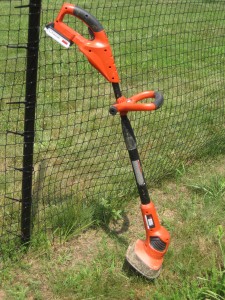
Our battery-powered cultivator, standing tall and proud
Now, it’s true that our vineyard is small. Right now we have only 150 vines, and the space they take up wouldn’t fill a small corner of even the smallest of the Commonwealth’s commercial vineyards. So we thought we could afford a few luxuries when it came to maintaining the vineyard. But it turns out that pulling weeds by hand is work – really, really, really hard work.
We started off a few weeks ago with nothing more than a hoe and our own hands. And by “we,” I mean my wife, the Vineyard Goddess, as I was still recovering from surgery on my cervical spine (Level 4 ACDF for those of you who know or care about these things). I was there in spirit, but it was the Vineyard Goddess who was working the soil with a hoe, and then kneeling down to pull the weeds by hand. I wasn’t actually there, but I have no doubt that it was slow, painful work.
And I know that, because we talked about it. I might have been unable to do physical labor, but I was still available as a consultant, and it occurred to me that there might be mechanical devices to help with this chore. Sure enough, there are. My preference would have been a small, gas-powered cultivator, but with our very steep slopes, we were concerned that we wouldn’t be able to control it well enough to avoid damage to the vines.
We looked at the somewhat smaller electrical tillers, both corded and battery-powered, and settled on the latter. The corded ones are probably perfect for a garden located next to the house, but our vineyard is a significant hike from the house. And the furthest rows are, as they say, “a fur piece.” Continue Reading–>
Grow Tubes Reconsidered
Those of you who have been following this blog know that I recently offered some unkind words about grow tubes, which many vineyards use to nurse along young vines. My criticism was based partly on research and partly on personal experience.
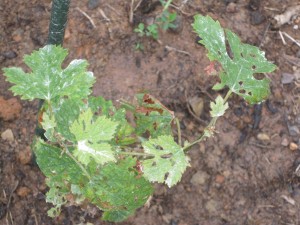
The Nelson vineyard vines, (do seven vines make a vineyard?) after removal of the tubes, leave a lot to be desired.
As I recounted, we had been told in one vineyard management class to use grow tubes, and then, in another, to get them off the vines post-haste. We had two points of reference.
First, our Fairfax vines, which were planted and nurtured without benefit of grow tubes, are doing spectacularly well. It’s possible, of course, that we’re just kidding ourselves, and the growth we’re seeing is the result of overly vigorous vines. While vigor is no
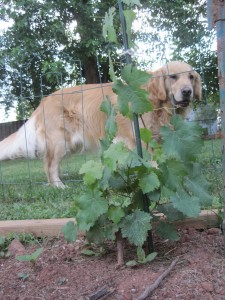
The Fairfax vines (all seven of them) seem to be flourishing, perhaps because Phoenix, the Vineyard Dog, stands guard over them.
doubt welcomed by farmers raising soy or corn, overly aggressive vines produce low-quality fruit. We want the vigor to go to the grapes, not the vines.
Be that as it may, the Fairfax vines appear strong and healthy. By contrast, the vines on our Nelson County property, which were planted with the protective shelter of grow tubes, seem, well, frail. They have holes in the leaves. Lots of holes. And scrawny, brown-looking leaves. Not what we had hoped for at all.
We wondered if the grow tubes were the problem. One of our friends who manages a large vineyard, urged us to take the tubes off, warning that, in this heat, all we were doing was baking the vines. We did some investigating on our own, and much of the research we looked at suggested that the only reason for using grow tubes is to facilitate the use of herbicides – the tubes protect the vine while Roundup or something like that clears vegetation out of the rows of vines.
So, we swore of grow tubes, and I wrote an angry rant about them. I haven’t changed my mind, but in fairness, I have to say that it appears that almost everyone else in this business loves grow tubes. Continue Reading–>
Goodbye to Grow Tubes Forever!
Apparently there’s no agreed-upon rule book for viticulture.
When we planted Cab Franc vines on our Nelson County property, we followed the advice offered at a class on that very subject at the Piedmont Virginia Community College (great curriculum –the best available in Virginia today), and covered them with grow tubes. We
did the same for the two Mammolo Tuscano vines which we had received as a gift from Gabriele Rausse, one of the founding fathers of the Virginia wine industry and the instructor for a class on grafting.
At another class over the weekend, we were told, in no uncertain terms, to take them off. Sigh.
After doing a lot of overnight research, we decided that the grow tubes – ours are the so-called “Blue X,” which consist of a blue plastic insert and a soft-skin translucent blue sleeve – had to go. But it was kind of a close call.
A lot of the research we looked at suggested that while grow tubes provide a hot-house environment that jump starts the growth of the vines in their early months, they also prevent the vines from achieving their potential. The focus of the first two years is developing a strong trunk and root system. As Julien, the vineyard manager at DuCard Vineyards, told me, you must be willing to do the work, and to do it when it needs to be done. And you must be willing to be patient. The tubes, he added, rushed the process and created a hot-house that could cook the vines to death in the 90-plus degree weather we’ve been having.
My wife, the Vineyard Goddess (and future Vineyard Manager), took Julien’s words to heart and found a good deal of evidence to support the anti-grow tube proposition. Continue Reading–>

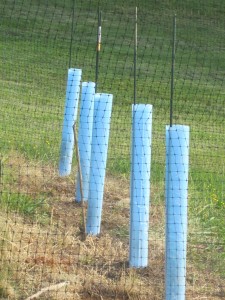


Recent Comments